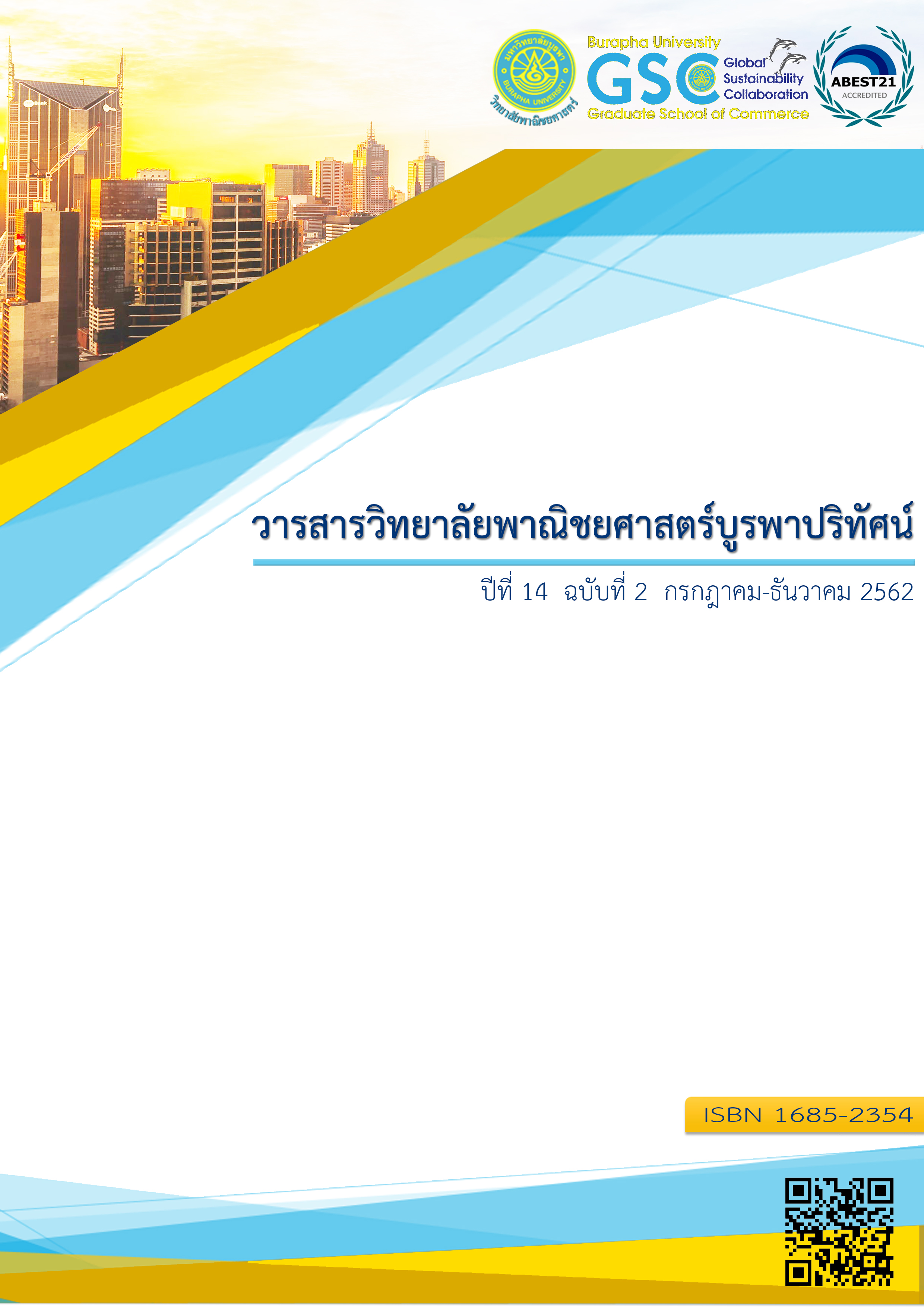การพัฒนาแบบจำลองการพิจารณาความน่าเชื่อถือทางการเงินสำหรับธุรกิจจดทะเบียนในตลาดหลักทรัพย์แห่งประเทศไทย
Main Article Content
บทคัดย่อ
การวิจัยนี้มีวัตถุประสงค์ (1) เพื่อศึกษาตัวแปรอัตราส่วนทางการเงิน ตัวแปรสัมพันธ์กับมูลค่าทางการตลาด และคุณลักษณะของธุรกิจที่สามารถพยากรณ์การพิจารณาความน่าเชื่อถือทางการเงินของธุรกิจ (2) เพื่อพัฒนาแบบจำลองการพิจารณาความน่าเชื่อถือทางการเงินสำหรับธุรกิจ (3) เพื่อทดสอบอิทธิพลเชิงสาเหตุของตัวแปรพยากรณ์ผลการพิจารณาความน่าเชื่อถือทางการเงินจากแบบจำลองที่พัฒนาขึ้นต่อผลตอบแทนของหลักทรัพย์ งานวิจัยนี้เป็นการวิจัยแบบผสมผสาน (Mixed Method) ระหว่างการวิจัยเชิงปริมาณ โดยเก็บรวบรวมข้อมูลทุติยภูมิ และเลือกกลุ่มตัวอย่างด้วยวิธีแบบจับคู่ (Matched Pair) ระหว่างบริษัทที่มีปัญหาทางการเงินและเป็นบริษัทที่ไม่มีปัญหาทางการเงิน และดำเนินการวิจัยเชิงคุณภาพโดยการเก็บรวบรวมข้อมูลจากการสัมภาษณ์เชิงลึกผู้เชี่ยวชาญ โดยวิธีการเลือกแบบเฉพาะเจาะจง (Purposive Sampling) ผลการวิจัยตัวแปรที่สามารถพยากรณ์การพิจารณาความน่าเชื่อถือทางการเงินของธุรกิจและการพัฒนาแบบจำลองการพิจารณาความน่าเชื่อถือทางการเงินสำหรับธุรกิจ โดยการวิเคราะห์ถดถอยโลจิสติกส์ พบว่า ตัวแปรอัตราส่วนทางการเงิน ได้แก่ อัตราส่วนเงินทุนหมุนเวียน อัตราส่วนเงินทุนหมุนเวียนสุทธิต่อสินทรัพย์รวม อัตราส่วนหมุนเวียนสินทรัพย์ไม่หมุนเวียน อัตราส่วนผลตอบแทนจากสินทรัพย์ อัตราผลตอบแทนจากส่วนของผู้ถือหุ้น ตัวแปรตัวแปรสัมพันธ์กับมูลค่าทางการตลาด คือ มูลค่าตลาดของสินทรัพย์ต่อจุดผิดนัดชำระหนี้ และตัวคุณลักษณะของธุรกิจ คือขนาดธุรกิจ มีอิทธิพลในการพยากรณ์และพัฒนาแบบจำลองการพิจารณาความน่าเชื่อถือทางการเงินสำหรับธุรกิจ โดยแบบจำลองมีความแม่นยำถึงร้อยละ 82.70
ส่วนผลการทดสอบตัวแปรอิทธิพลของผลการพิจารณาความน่าเชื่อถือทางการเงินจากแบบจำลองที่พัฒนาขึ้นต่อผลตอบแทนของหลักทรัพย์ โดยการใช้การวิเคราะห์เส้นทาง (Path Analysis) พบว่า ตัวแปรเชิงสาเหตุในแบบจำลองที่ส่งผลทั้งทางตรงและทางอ้อมต่อผลตอบแทนหลักทรัพย์ ประกอบด้วย อัตราส่วนเงินทุนหมุนเวียน อัตราส่วนเงินทุนหมุนเวียนสุทธิต่อสินทรัพย์รวม อัตราส่วนหมุนเวียนสินทรัพย์ไม่หมุนเวียน มูลค่าตลาดของสินทรัพย์ต่อจุดผิดนัดชำระหนี้ ส่วนขนาดธุรกิจมีนัยสำคัญเพียงการส่งผลในทางตรงต่อผลตอบแทนหลักทรัพย์ ทั้งนี้ ผลในภาพรวม พบว่า แบบจำลองเชิงสาเหตุมีความสอดคล้องกลมกลืนกับข้อมูลเชิงประจักษ์โดยมีค่าความสอดคล้องผ่านเกณฑ์ความสอดคล้องทุกค่า พร้อมทั้งผลการวิจัยเชิงคุณภาพ พบว่า ผู้เชี่ยวชาญทั้งหมดเห็นด้วยกับผลการวิจัยเชิงปริมาณที่พัฒนาขึ้น
Article Details
เจ้าของบทความมิได้คัดลอก หรือละเมิดลิขสิทธิ์ของผู้ใด หากเกิดการละเมิดลิขสิทธิ์ ไม่ว่าวิธีใด หรือการฟ้องร้องไม่ว่ากรณีใด ๆ ที่อาจเกิดขึ้นได้ กองบรรณาธิการวารสารวิทยาลัยพาณิชยศาสตร์ไม่มีส่วนเกี่ยวข้องทั้งสิ้น ให้เป็นสิทธิ์ของเจ้าของบทความที่จะดำเนินการ
เอกสารอ้างอิง
ธนาคารแห่งประเทศไทย. (2561c). รายงานผลการสำรวจภาวะและแนวโน้มสินเชื่อ ไตรมาสที่ 3 ปี 2561. กรุงเทพฯ.
ธนาคารแห่งประเทศไทย. (2562). ข้อมูล: ยอดคงค้างเงินให้สินเชื่อรวม. สืบค้น 19 มกราคม 2562. เข้าถึงได้จาก https://www.bot.or.th/App/BIZSHR/stat/Graph/
สำนักงานกระทรวงการคลัง. (2560). รายงานประมาณการเศรษฐกิจไทยปี 2560. สืบค้น 25 สิงหาคม 2560. เข้าถึงได้จาก https://www.mof.go.th/en/view/file/8f932e75cc52ca22061b18bc1b9b0a090609b0e048fda5db0d
Aleksanyan, L., & Huiban, J.-P. (2016). Economic and financial determinants of firm bankruptcy: evidence from the French food industry. Review of Agricultural, Food and Environmental Studies, 97(2), 89-108.
Bandyopadhyay, A. (2007a). Mapping Corporate Drift toward Default: Part1: A Market-Based Approach. Journal of Risk Finance, 8(1), 35-45.
Bandyopadhyay, A. (2007b). Mapping Corporate Drift toward Default: Part 2: A Hybrid Credit-Scoring Model. The Journal of Risk Finance, 8(1), 46-55.
Chen, P. F., & Zhang, G. (2007). How Do Accounting Variables Explain Stock Price Movements? Theory and Evidence. Journal of Accounting and Economics, HKUST Business School Research Paper no. 07-02.
Chava, S., & Purnanandam, A. (2010). Is Default Risk Negatively Related to Stock Returns? The Review of Financial Studies, 23, 2523-2559.
Chijoriga, M. M. (2011). Application of Multiple Discriminant (MDA) as A Credit Scoring and Risk Assessment Model. International Journal of Emerging Market, 6(2), 132-147.
Dastoori, M., & Mansouri, S. (2013). Credit Scoring Model for Iranian Banking Customers and Forecasting Creditworthiness of Borrowers. International Business Research, 6(10), 25-39.
Din, W. U. (2017). Stock Return Predictability with Financial Ratios: Evidence from PSX 100 Index Companies. International Journal of Basic Sciences & Applied Research, 6(3), 269-280.
Doron, A., Tarun, C., Gergana, J., & Alexander, P. (2009). Credit Rating and the Cross Section of Stock Returns. Journal of Financial Marketing, 469-499.
Emawtee., B.-B., & Brooks., R. (2015). The Credit Risk - Return Puzzel: Impact of Credit Rating Announcements in Australia and Japan. Pacific - Basin Finance Journal, 35, Part A, 37-55.
Fisher, K. L. (1984). Super Stocks (1st ed.). Homewood, Illinois: Dow Jones-Irwin.
Gumparthi, S., Manickavasagam, D. V., & Ramesh, M. (2010). Credit Scoring Model for Auto Ancillary Sector. International Journal of Innovation, Management and Technology, 1(4), 362-373.
Gupta, V. (2014). An Empirical Analysis of Default Risk for Listed Companies in India: A Comparison of Two Prediction Model. International Journal of Business and Management, 9(9), 223-234.
Jabbari, E., & Fathi, Z. (2014). Prediction of Stock Returns using Financial Ratios based on Historical Cost, Compared with Adjusted Prices (Accounting for Inflation) with Neural Network Approach. Indian Journal of Fundamental and Applied Life Sciences, 4(S4), 1064-1078
Khotimah, K., & Murtaqi, I. (2015). The Fundamental Analysis of Indonesian Stock Return (Case Study: Listed Public Companies in Sub-Sector Food and Beverage for the Period 2003-2012). Journal of Business and Management. 4(1), 95-104.
KMV., M. s. (2003, December, 18). Modeling Default Risk. Technical Working Paper.
Merton, R. C. (1974). On the Pricing of Corporate Debt: The Risk Structure of Interest Rates. Journal of Finance, 29(2), 449-470.
Mondal, L. (2008). A Dynamic Hybrid Credit Scoring Model: A Two-stage Prediction of Credit Quality. Dissertation of Ph.D. in Management Science, College of the Illinois Institute of Technology.
Musallam, S. R. (2018). Exploring the Relationship between Financial Ratios and Market Stock Returns. Eurasian Journal of Business and Economics, 11(12), 101-106.
Poon, M. A. (2012). What lenders see -- : a history of the Fair Isaac scorecard. Doctor of Philosophy, University of California, San Diego.
Vruwink, D. R., Quirin, J. J., & O'Bryan, D. (2007). A Modified Price-Sales Ratio: A Useful Tool For Investors? Journal of Business & Economics Research, 5(12), 31-40.
Auerbach, A. (2005). Business Builder 6: How to Analyze Your Business Using Financial Ratios. Utah: Edward Lowe Foundation.


